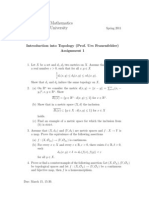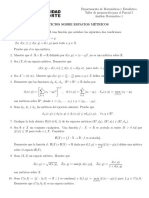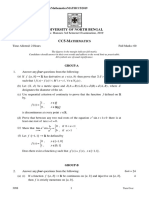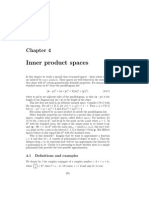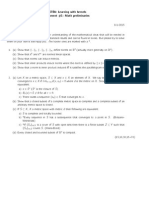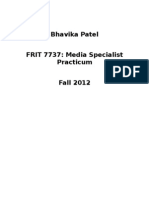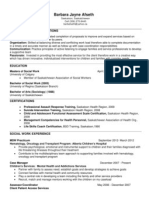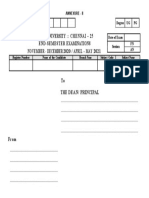Examples 1
Examples 1
Uploaded by
SonozixOriginal Description:
Copyright
Available Formats
Share this document
Did you find this document useful?
Is this content inappropriate?
Report this DocumentCopyright:
Available Formats
Examples 1
Examples 1
Uploaded by
SonozixCopyright:
Available Formats
Metric and topological spaces, Easter 2008
BJG
Example Sheet 1
1. Give an example of a metric space X which has a closed ball of radius 1.001 which contains 100 disjoint closed balls of radius one. 2. Show that the sequence 2008, 20008, 200008, 2000008, . . . converges in the 5-adic metric. 3. Suppose that R R is endowed with one of the product metrics dened in lectures (pick your favourite). Show that the map f : R R R dened by f (x, y) = x + y is continuous. 4. Suppose that (X, d) is a metric space and that X X is endowed with the product metric d((x, x ), (y, y )) = d(x, y) + d(x , y ). Show that the metric d, viewed as a map from X X to R, is continuous. 5. By a norm on Rn we mean a function : Rn R 0 for which x = 0 if and only if x = 0, for which x + y x + y , and such that x = || x for all R. Show that any norm denes a metric on Rn by the rule d(x, y) = x y . Suppose now that (X1 , d1 ), . . . , (Xn , dn ) are metric spaces. Wikipedia says that the function d dened by d((x1 , x2 , . . . , xn ), (x , x , . . . , x )) = (d1 (x1 , x ), . . . , dn (xn , x ))
1 2 n 1 n
is a metric on X1 Xn . Do you believe this?
6. Suppose that (X1 , d1 ), (X2 , d2 ), . . . are metric spaces. Prove the claim made in lectures, that 1 di (xi , xi ) d((x1 , x2 , . . . ), (x1 , x2 , . . . )) = 2i 1 + di (xi , xi ) i=1 denes a metric on the countably innite product
i=1
Xi .
7. How many topologies are there on the set {1, 2}? Show that if n > 1 then there are at least 2n dierent topologies on the set {1, . . . , n}. Is the number of topologies on {1, . . . , n} bounded above by C n , for some universal constant C? 8. Give an example of an innite topological space X which is homeomorphic to X X. 9. Exhibit a countable basis for the usual topology on R. 10. Suppose that C[0, 1] is endowed with the L2 -metric d(f, g) = Is it complete?
1Update: 1 0
|f (x) g(x)|2 dx.
I am pleased to report that next years example sheet will see says replaced by said.
1
11. Which of the following pairs of topological spaces are homeomorphic? Justify your answers. [Hint: Im not sure all of this can be done using material from the rst six lectures of the course.] (i) (ii) (iii) (iv) (v) A coee mug and a doughnut; C[0, 1] and C[0, 2] (both with the metric d(f, g) = max |f (x) g(x)|); (0, 1) and [0, 1]; {0, 1, . . . , 9}N and [0, 1]; R2 \ {0} and R2 \ {x : |x| 1}.
12. Is Q complete in the 2-adic metric? 13. For this question we work in Rn with the Euclidean metric. Show that there do not exist two disjoint closed unit balls inside any closed ball of radius 2. Show that there do, however, exist (1 + c)n disjoint closed unit balls inside any closed ball of radius 3.001, for some absolute constant c > 0. Do there exist exponentially many disjoint closed unit balls inside a closed ball of radius 2.001? 14. Suppose that A is a set inside some topological space X. Show that no more than 14 distinct sets may be obtained from A by repeated applications of the closure, interior and complementation operations (e.g. the closure of the complement of the closure of the closure of the complement of the complement of A). Show furthermore that 14 is the best possible constant in this result. 15. Show that the set S C[0, 1] consisting of continuous functions which map Q to Q is dense, where the metric on C[0, 1] is dened by d(f, g) = max |f (x) g(x)|.
Version of October 12th, 2008. Please email corrections and comments to [email protected].
You might also like
- (2012) High-Performance-CultureDocument44 pages(2012) High-Performance-CultureHon Cheong100% (1)
- Department of Mathematics Seoul National University: Introduction Into Topology (Prof. Urs Frauenfelder) Assignment 1Document1 pageDepartment of Mathematics Seoul National University: Introduction Into Topology (Prof. Urs Frauenfelder) Assignment 1ChoHEEJeNoch keine Bewertungen
- Assignment 3Document2 pagesAssignment 3James AttenboroughNoch keine Bewertungen
- Metric Space: X X y yDocument20 pagesMetric Space: X X y yWazha MmerekiNoch keine Bewertungen
- Topology Short Noticesn4eee44Document31 pagesTopology Short Noticesn4eee44faisal chathaNoch keine Bewertungen
- Topology Short NoticesDocument12 pagesTopology Short Noticesfaisal chathaNoch keine Bewertungen
- Tut 2Document2 pagesTut 2vaishalic2304Noch keine Bewertungen
- 3210 CourseDocument57 pages3210 CourseHayat ullahNoch keine Bewertungen
- Assignment 4Document2 pagesAssignment 4James AttenboroughNoch keine Bewertungen
- 1 2 X 1 2 X X (,1) X X X (,1) 1 N 1 2 N I 1 X 1 2 1 NDocument5 pages1 2 X 1 2 X X (,1) X X X (,1) 1 N 1 2 N I 1 X 1 2 1 Ntbrackman99Noch keine Bewertungen
- MA2223 ch1 PDFDocument16 pagesMA2223 ch1 PDFRAJESH KUMARNoch keine Bewertungen
- Open Balls and Neighborhoods in Metric SpacesDocument8 pagesOpen Balls and Neighborhoods in Metric Spacesoskar.lawryniukNoch keine Bewertungen
- Assignment 2Document2 pagesAssignment 2James AttenboroughNoch keine Bewertungen
- Adv - Meas - Theory - DU Question 2021 SEM IVDocument2 pagesAdv - Meas - Theory - DU Question 2021 SEM IVsamyaNoch keine Bewertungen
- Homework 1 Graduate Real AnalysisDocument4 pagesHomework 1 Graduate Real AnalysislordpersonNoch keine Bewertungen
- Assignment 2Document2 pagesAssignment 2Rupam KumawatNoch keine Bewertungen
- Metric SpacesDocument42 pagesMetric SpacesAmol MittalNoch keine Bewertungen
- Algebra SeminarDocument13 pagesAlgebra SeminarLorin AtzbergerNoch keine Bewertungen
- University of Portsmouth M312 Final Exam 2014Document2 pagesUniversity of Portsmouth M312 Final Exam 2014WallaceNoch keine Bewertungen
- 07 Chapter1Document58 pages07 Chapter1Mehwish QadirNoch keine Bewertungen
- Madhava MC Paper 12Document2 pagesMadhava MC Paper 12Aman-SharmaNoch keine Bewertungen
- Real (Mid1)Document1 pageReal (Mid1)akashNoch keine Bewertungen
- HW 5Document2 pagesHW 5Noe MartinezNoch keine Bewertungen
- Problem Set 2: Topological Spaces: Your Name: Due: Thursday, February 11Document2 pagesProblem Set 2: Topological Spaces: Your Name: Due: Thursday, February 11anthalyaNoch keine Bewertungen
- Chapter 2. Normed Linear Spaces: The BasicsDocument2 pagesChapter 2. Normed Linear Spaces: The BasicsMuhammad ShoaibNoch keine Bewertungen
- IV-22-Ring of PolynomialsDocument7 pagesIV-22-Ring of PolynomialsSekar ayu LestariNoch keine Bewertungen
- WSU Maths BootcampDocument122 pagesWSU Maths BootcampMontage MotionNoch keine Bewertungen
- Exercise Sheet 1Document1 pageExercise Sheet 1Luis Octavio Quiroz MarambioNoch keine Bewertungen
- MMT 004Document5 pagesMMT 004romeoahmed687Noch keine Bewertungen
- 1084-Article Text-4070-1-10-20141013Document17 pages1084-Article Text-4070-1-10-20141013Prasoon PandeyNoch keine Bewertungen
- Stability of P Order Metric RegularityDocument7 pagesStability of P Order Metric RegularityHữu Hiệu ĐoànNoch keine Bewertungen
- University of Portsmouth M312 Final Exam 2013Document2 pagesUniversity of Portsmouth M312 Final Exam 2013WallaceNoch keine Bewertungen
- Tutorial Sheet 4Document1 pageTutorial Sheet 4nirmalaNoch keine Bewertungen
- Metric Space and Norm Linear Space Important QuestionsDocument3 pagesMetric Space and Norm Linear Space Important QuestionsP GOSWAMINoch keine Bewertungen
- Series 1: April 2020Document5 pagesSeries 1: April 2020Bob CrossNoch keine Bewertungen
- The Completion of Generalized B-Metric Spaces and Fixed PointsDocument19 pagesThe Completion of Generalized B-Metric Spaces and Fixed PointsSafoora ElienNoch keine Bewertungen
- DocumentDocument3 pagesDocumentmtheoroNoch keine Bewertungen
- International Journal of Pure and Applied Mathematics No. 3 2015, 325-337Document14 pagesInternational Journal of Pure and Applied Mathematics No. 3 2015, 325-337Soumya DasguptaNoch keine Bewertungen
- Taller Sobre Espacios MetricosDocument2 pagesTaller Sobre Espacios MetricosCésar RincónNoch keine Bewertungen
- 3098 Mathcc5 L 3Document4 pages3098 Mathcc5 L 3neetmonthsNoch keine Bewertungen
- JRF Mathematics Examination RMI: K nk+1 NKDocument2 pagesJRF Mathematics Examination RMI: K nk+1 NKLeo SchizoNoch keine Bewertungen
- Choudhary) - Metric SpacesDocument28 pagesChoudhary) - Metric SpacesKhmer ChamNoch keine Bewertungen
- Fulltext 008Document15 pagesFulltext 008মেঘে ঢাকা তারাNoch keine Bewertungen
- Metrics PDFDocument42 pagesMetrics PDFKshitijPatilNoch keine Bewertungen
- TYBSC - Sem. - III (2013) 2016Document225 pagesTYBSC - Sem. - III (2013) 2016Pratik BorkarNoch keine Bewertungen
- Homework Assignment 1Document3 pagesHomework Assignment 1Serkan KalpakNoch keine Bewertungen
- 1011sem1 Ma2213Document4 pages1011sem1 Ma2213jlee970125Noch keine Bewertungen
- ps4 For EC5104RDocument5 pagesps4 For EC5104RLee Zhi KangNoch keine Bewertungen
- Homework 1Document3 pagesHomework 1Hoang Trung NguyenNoch keine Bewertungen
- Assignment 3Document2 pagesAssignment 3pritibiswasprojectwork2.0Noch keine Bewertungen
- 3rd Sem AnalysisDocument5 pages3rd Sem AnalysisPRATIKNoch keine Bewertungen
- FA Chap4 1-4 PDFDocument4 pagesFA Chap4 1-4 PDFJuan Carlos Moreno OrtizNoch keine Bewertungen
- D (X, Y) 1+d (X, Y)Document1 pageD (X, Y) 1+d (X, Y)mariab1989Noch keine Bewertungen
- Exercises in AnalysisDocument78 pagesExercises in AnalysiseasonrevantNoch keine Bewertungen
- CV 201008 Complex Analysis Qualifier Exam, August 2010Document3 pagesCV 201008 Complex Analysis Qualifier Exam, August 2010Christopher BreedenNoch keine Bewertungen
- Homework 3: X Z Y W X×Y X YDocument2 pagesHomework 3: X Z Y W X×Y X YLuis EduardoNoch keine Bewertungen
- Metric SpacesDocument11 pagesMetric SpacesVibina JosephNoch keine Bewertungen
- Anal 2Document5 pagesAnal 2florezjulian74Noch keine Bewertungen
- CS678A: Learning With Kernels Assignment #1: Math PreliminariesDocument1 pageCS678A: Learning With Kernels Assignment #1: Math PreliminariesAyush SekhariNoch keine Bewertungen
- Assignment I: (To Be Submitted in Tutorial Class by September 13, 2019)Document2 pagesAssignment I: (To Be Submitted in Tutorial Class by September 13, 2019)AnantaRajNoch keine Bewertungen
- Vision IAS Prelims 2019 CSAT Test 7 With Solution Hindi (@PDF4Exams)Document51 pagesVision IAS Prelims 2019 CSAT Test 7 With Solution Hindi (@PDF4Exams)Eder EliakimNoch keine Bewertungen
- HDL-MR0410 431Document2 pagesHDL-MR0410 431DavidLagosNoch keine Bewertungen
- Usaid - Stip 2023Document21 pagesUsaid - Stip 2023Walter Esteban Ita EspinozaNoch keine Bewertungen
- NewspaperDocument2 pagesNewspaperapi-285467658Noch keine Bewertungen
- Các câu nổi bật ĐH 2020Document6 pagesCác câu nổi bật ĐH 2020Hà ChiNoch keine Bewertungen
- UBD Civil WarDocument11 pagesUBD Civil Warbp02054Noch keine Bewertungen
- Bigtow Detach Trailer Manual 09 1 2004Document80 pagesBigtow Detach Trailer Manual 09 1 2004ปรัชญา สังขรัตน์Noch keine Bewertungen
- Measurement and Application of Zeta PotentialDocument5 pagesMeasurement and Application of Zeta PotentialSiêu Nhân Kem XôiNoch keine Bewertungen
- Health Facility Briefing and Design FDocument25 pagesHealth Facility Briefing and Design Farshveer.jibreelNoch keine Bewertungen
- Dataart Payment Processing ExpertiseDocument28 pagesDataart Payment Processing ExpertiseErinda MalajNoch keine Bewertungen
- The Natural WorldDocument3 pagesThe Natural WorldĐỗ LinhNoch keine Bewertungen
- Project Implementation LP06Document69 pagesProject Implementation LP06Wan Mohamad Noor Hj IsmailNoch keine Bewertungen
- Difference Resume, C.V. and BiodataDocument2 pagesDifference Resume, C.V. and BiodataKashyap PatelNoch keine Bewertungen
- Central Procurement Organization (Marketing) Bharat Petroleum Corporation LimitedDocument199 pagesCentral Procurement Organization (Marketing) Bharat Petroleum Corporation LimitedTENDER AWADH GROUPNoch keine Bewertungen
- TLStiming PDFDocument18 pagesTLStiming PDFDavid MagalhãesNoch keine Bewertungen
- Producers, Consumers & DecomposersDocument1 pageProducers, Consumers & Decomposerssantanu40580Noch keine Bewertungen
- LiberalismDocument2 pagesLiberalismMicah Kristine Villalobos100% (1)
- OPT Employee Relationship ManagementDocument29 pagesOPT Employee Relationship ManagementMuhammad Shahroz AfzalNoch keine Bewertungen
- RoutledgeHandbooks 9781315852515 Chapter22Document12 pagesRoutledgeHandbooks 9781315852515 Chapter22Bisma HussainNoch keine Bewertungen
- Ready To Apply For The MLH Fellowship? (Page 1 /11)Document9 pagesReady To Apply For The MLH Fellowship? (Page 1 /11)Binod BinodNoch keine Bewertungen
- Vol I LS 89Document300 pagesVol I LS 89Penmetsa Satyanarayana RajuNoch keine Bewertungen
- Pair of Lines Second Degree General EquationDocument29 pagesPair of Lines Second Degree General Equationarjunsai100% (1)
- David KriegDocument15 pagesDavid Kriegapi-227236963Noch keine Bewertungen
- Barb Resume Revised May 30Document2 pagesBarb Resume Revised May 30api-137300550Noch keine Bewertungen
- My Thoughts: 4. Present An Overview of Media Support System?Document2 pagesMy Thoughts: 4. Present An Overview of Media Support System?sujata dhakalNoch keine Bewertungen
- CAE Listening Practice Test 1 Printable: New, Online Version of This Test Answer Keys TapescriptDocument2 pagesCAE Listening Practice Test 1 Printable: New, Online Version of This Test Answer Keys TapescriptHòa KimNoch keine Bewertungen
- Annexure 2Document1 pageAnnexure 2Vijay MNoch keine Bewertungen
- The Philosophical Breakfast Club by Laura J. Snyder - ExcerptDocument21 pagesThe Philosophical Breakfast Club by Laura J. Snyder - ExcerptCrown Publishing Group100% (7)

